Are you trying to bulk up by eating 6 meals a day? Then you have found the right place! Because today I will be teaching you how to eat 6 meals a day to gain muscle as a skinny dude.
Eating 6 meals a day to gain muscle requires you to first determine the daily calories and macronutrients required by your body to build muscle. This allows you to portion the calories and macronutrients across breakfast, lunch, pre-/post-workout, dinner, and pre-bed meals.
As an ex-130lb skinny lad myself, I still remember my first steps into a 6-meal-a-day program. I knew it would help me bulk up but just didn’t know where to begin.
In fact, I still vividly remember the headache. How do I know if I’m over-consuming? Or under-consuming? What should I even be eating?!
If this sounds like you, then keep scrolling!
Because today- I’ll be sharing my own personal experience and research.
Are you ready?
Let’s go!

Me on 6 meals a day! (Well this is actually 6 meals in one, but hey ho)
- Example- A 130lb Male With 11% Body Fat
- Calculating Your Calories Required To Gain Muscle
- Calculating Your Macronutrient Quota Required To Gain Muscle
- Split Your Calories And Macros Across 6 Meals A Day
- 1. Breakfast: 20% Of Your Daily Calories And Macros
- 2. Lunch: 15% Of Your Daily Calories And Macros
- 3. Pre-Workout: 25% Of Your Daily Calories And Macros
- 4. Post-Workout: 25% Of Your Daily Calories And Macro
- 5. Dinner: 10% Of Your Daily Calories And Macros
- 6. Pre-Bed: 5% Of Your Daily Calories And Macros
- Conclusion
Example- A 130lb Male With 11% Body Fat
To address how you should eat 6 meals a day to gain muscle, I will use a 130lb male with 11% body fat as an example.
I have chosen to use these metrics based on 2 reasons:
- Personal experience- these were my measurements when I was a skinny guy 2 years ago.
- Average skinny guy – these are measurements that I feel represent the average skinny guy (or close to).
Furthermore, I will use a lean bulking approach to gain muscle. If you don’t know already, a lean bulk involves eating a 5-15% caloric surplus.
Again, I have chosen a lean bulking approach as an example because I have personally done it myself (so I know it works!).
Additionally, I would always recommend skinny beginners to try a lean bulk before experimenting with more extreme caloric surpluses.
You know, a one step at a time kinda thing.
If you want to learn how long to bulk for, you can check out my guide on lean bulking duration!
Therefore, this post will be explaining how to eat 6 meals a day to gain muscle as a 130lb skinny guy. But the methods can be applied regardless of your weight. Just alter the numbers. I will teach you how!
If you want to learn more about lean bulking, you can check out my guide on bulking with minimal fat gains!
Next, I will explain how to determine your daily target calories required to go lean bulk.
Calculating Your Calories Required To Gain Muscle
Before you start planning how to eat 6 meals a day to gain muscle, you will need to calculate how many daily calories you require.
Doing this, it will allow you to figure out how large or small your 6 meals should be.
First, you will need to determine your total daily energy expenditure.
Don’t panic- this is an easy process!
I like to use this TDEE calculator which makes the process very simple. From my experience, it’s also relatively accurate (as accurate as an online calculator can be!).
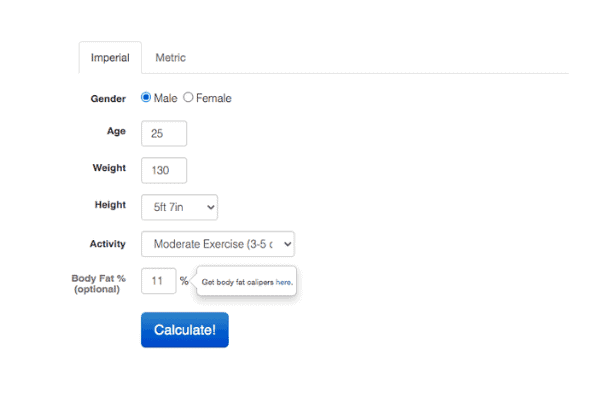
First, you need to plug in your details.
Most of the metrics are quite self-explanatory.
But “activity level” may stump some people.
To determine your activity level, simply establish how many days per week you are training.
For most skinny newbies, this will be between 3-5 days (this is the recommended weekly training session per week to gain muscle).
Therefore your activity level would be “Moderate”.
Now you can click calculate, and you will be provided with your daily maintenance calories!
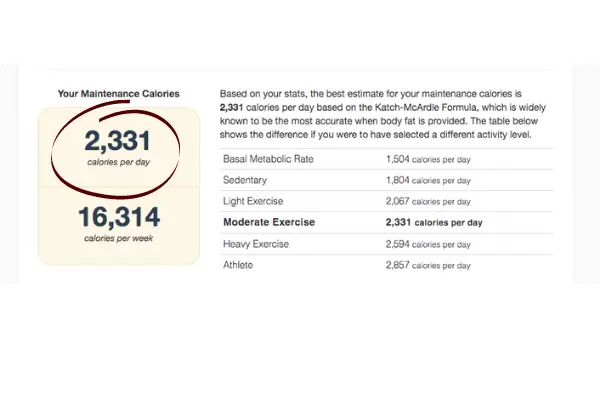
Next, you will need to determine your 15% surplus calories for a lean bulk.
To do this, simply multiply your maintenance calories by 1.15.
So if your maintenance calories are 2330, then your surplus calories would be 2680 calories (2330 x 1.15).
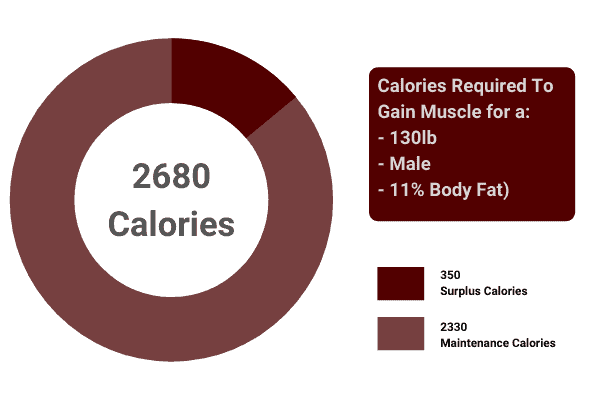
Therefore as a 5ft 7, 130lb skinny guy (11% body fat), you would need to consume 2680 calories every day to gain muscle. 2330 of these calories are maintenance (to maintain your current body weight), and 350 calories are surplus calories (to gain muscle). Now you know how many calories to split over your 6 meals!
Calculating Your Macronutrient Quota Required To Gain Muscle
The second thing you will need to do before planning how to eat 6 meals a day to gain muscle, is to calculate your daily macronutrient quota.
This refers to the number of macronutrients your body requires to build muscle mass.
Therefore your macronutrient quota will help you determine what ingredients should be in each of your 6 meals.
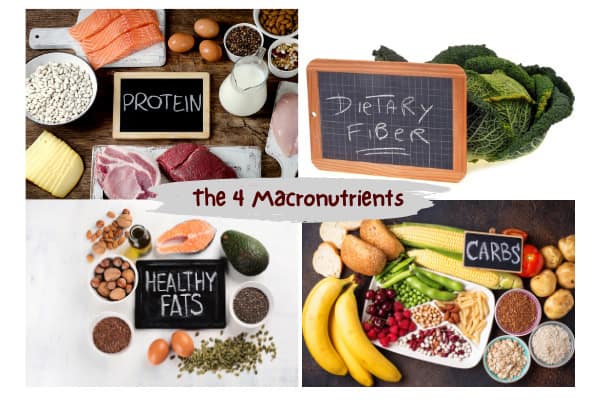
So what are the macronutrients?
The 4 main macronutrients required for gaining muscle are:
- Protein.
- Complex carbohydrates.
- Healthy fats.
- Dietary fiber.
Combined, these 4 macronutrients will provide the energy and raw resources for your body to fuel the muscle-building process.
Lucky for you, I have compiled my research into a macronutrient table (see below)!
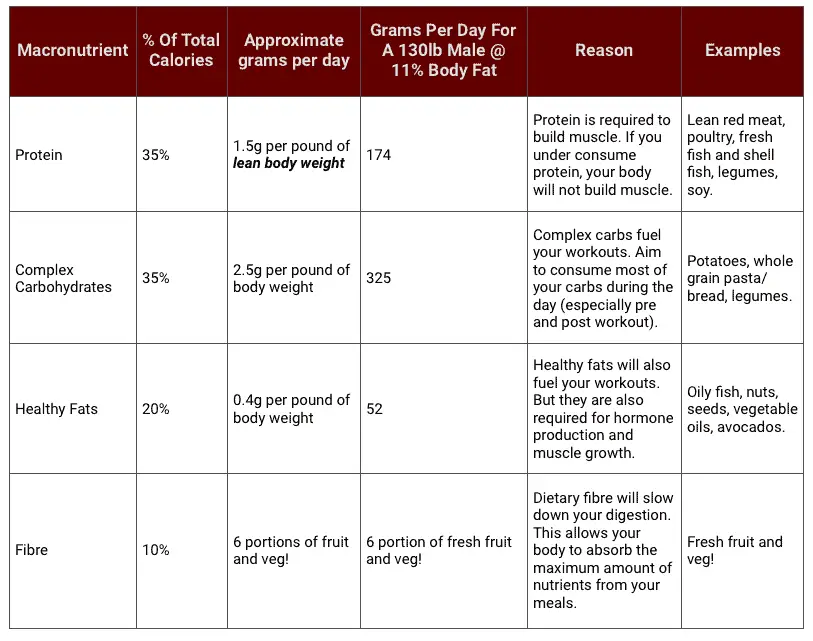
Therefore as a 130lb skinny guy, you should consume a daily total of 174g of protein, 325g of complex carbohydrates, 52g of healthy fats, and 6 portions of fresh fruit and veg! Now all you have to do is divide this quota among your 6 meals!
Split Your Calories And Macros Across 6 Meals A Day
Now you know how many calories you need to consume and your macronutrient quota, you can begin planning how to eat 6 meals a day to gain muscle.
I would recommend spacing your meals over the entire day, with 3-4 hours between each meal. By spreading your calories this way, you will more effectively regulate your meal sizes.
In other words, you won’t have to cram 2 meals into one!
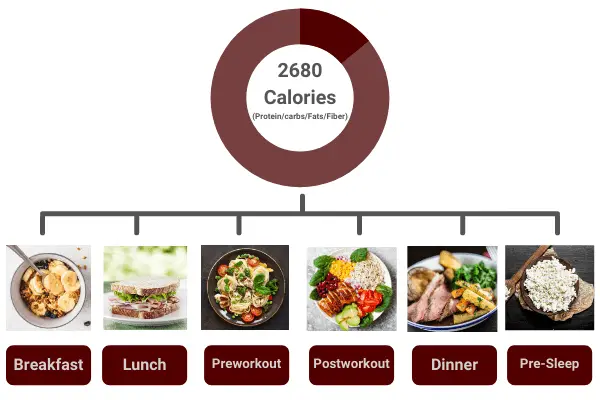
By scheduling your meals this way, you will prevent large insulin spikes (as a result of large meals). And this will reduce the lethargy associated with consuming overly-large meals.(1)
I would also recommend consuming the majority of your calories throughout the day. Furthermore, you should aim to consume meals immediately before and after a workout!
Let me explain.
1. Breakfast: 20% Of Your Daily Calories And Macros
Breakfast should contain approximately 20% of your daily calories and macros.
This is arguably one of the most important meals of the day. And numerous studies have shown that consuming a nutritious breakfast correlates with increased muscle strength and mass gains.(2)
This is not too surprising, considering you have essentially starved your body for the entire duration of your sleep.
Therefore a strong breakfast will allow your body to refuel from its fast.
Additionally, a big breakfast will help to expand your stomach. And this will set you up for a day of eating!
| Macronutrient | Approximate Grams |
|---|---|
| Protein | 35 |
| Complex Carbohydrates | 65 |
| Healthy Fats | 10 |
| Fibre | 1 portion of fruit or veg. |
| Calories | 536 |
Many people do not have a big appetite immediately after waking up. And this can be especially true for skinny guys.
Therefore it’s important to include appetizing foods in your breakfast.
I like to get an early dose of protein and fats from a tasty protein shake made with milk. By adding some oats and berries to the shake, you can also hit your carb and fiber intake too! I call this a calorie grenade. And I have been using it for over 2 years now!
2. Lunch: 15% Of Your Daily Calories And Macros
Lunch should account for approximately 15% of your daily calories and macros.
Now, this is not a lunch by your traditional standards.
In fact, it may even be considered a light brunch snack.
However, even a small lunch will help contribute to your daily calorie and macronutrient target.
| Macronutrient | Approximate Grams |
|---|---|
| Protein | 26 |
| Complex Carbohydrates | 49 |
| Healthy Fats | 8 |
| Fibre | 1 portion of fruit or veg. |
| Calories | 402 |
Eating a light lunch a few hours after breakfast will serve to maintain your blood protein and glucose levels. And this will sustain muscle growth.(3)
I like to make my lunch snack with a sandwich using wholegrain bread. This provides a dose of complex carbs, as well as plant protein. Then you can use grilled chicken and a choice of veg as the filling to complete your protein, fat, and fibre intake for lunch!
3. Pre-Workout: 25% Of Your Daily Calories And Macros
A pre-workout meal should account for another 25% of your daily calories and macros.
The pre-workout is simply a meal you eat a couple of hours before a workout, and it’s another essential meal to consume during the day.
In fact, a study has shown that a carbohydrate-rich pre-workout meal increases energy utilization in the muscles. And this has been attributed to increased glycogen levels.(4)
To put it simply, consuming a nutritious pre-workout will provide the energy for your muscles to work harder.
And this will increase muscle gain!
| Macronutrient | Approximate Grams |
|---|---|
| Protein | 44 |
| Complex Carbohydrates | 81 |
| Healthy Fats | 13 |
| Fiber | 1 portion of fruit or veg. |
| Calories | 670 |
I always have a pasta-based dish as my pre-workout. Furthermore, the pasta should always be wholegrain.
This is because whole-grain foods are absorbed more slowly by the body. And this will provide a controlled release of energy during your workout.(5)
The great thing about pasta dishes is their versatility. It contains good quantities of complex carbohydrates, protein, and fiber.
You can also add lean meat or fish of your choice to bump up the protein.
And the best thing?
Everyone loves pasta! (well, most people do).
Do you want to learn how how to gain muscle fast? Then check out my 14 nutrition and training tips to build muscle quickly!
I love eating pre-workout meals made with whole-grain pasta. And if you like pasta, then I recommend you to do so too! You can then add, grilled chicken, herbs, and olive oil to ramp up the protein and fats! If you don’t eat poultry, then tinned tuna is a great alternative!
4. Post-Workout: 25% Of Your Daily Calories And Macro
A post-workout meal should contribute a further 25% of your daily calories and macros.
Unlike the pre-workout, the post-workout meal is consumed within a couple of hours after a workout. And just like the pre-workout, a post-work-out meal is also vital to effectively gain muscle.
| Macronutrient | Approximate Grams |
|---|---|
| Protein | 44 |
| Complex Carbohydrates | 81 |
| Healthy Fats | 13 |
| Fiber | 1 portion of fruit or veg. |
| Calories | 670 |
In support of this, numerous studies have indicated that a nutritious post-workout meal is associated with increased muscle-building potential. And this has been credited to an increased protein synthesis and glycogen repletion rate after consuming post-workout calories.(6)
In other words, a good post-workout meal will help your muscles recover more efficiently!
I recommend a post-workout meal made with whole-grain rice and legumes (such as kidney beans). Just like whole-grain pasta, this provides a good amount of carbs, plant protein, and fiber. You can then add your favorite protein source to complete your protein and fat intake. Alternatively, make a hefty-sized sandwich for a more convenient option!
5. Dinner: 10% Of Your Daily Calories And Macros
Next, dinner should account for approximately 10% of your daily calories and macros.
Although this may sound like a relatively small dinner, it really depends.
It depends on what time you work out and what time you consume your post-workout meal.
| Macronutrient | Approximate Grams |
|---|---|
| Protein | 18 |
| Complex Carbohydrates | 33 |
| Healthy Fats | 5 |
| Fiber | 1 portion of fruit or veg. |
| Calories | 268 |
If you like to work out in the evening (and many people do), then it makes sense to treat your post-workout as a dinner meal. Therefore, your second dinner is more like an evening snack.
Alternatively, if you prefer to work out during the daytime, then you could more evenly spread the calories between a post-workout and dinner meal.
Therefore, you should afford some flexibility when deciding how to eat 6 meals a day.
For an evening dinner snack, I recommend a simple roast dinner. To do this, you can put potatoes (sweet potatoes are awesome), veg, and meat/fish into an oven. Then you add your favorite herbs and spices to take things to the next level. This is a quick and easy meal to supplement your calories and macros. And this makes it great, as it frees up some of your time to do other stuff! Use the time saved to prepare your meals for tomorrow!
6. Pre-Bed: 5% Of Your Daily Calories And Macros
Finally, a pre-bed meal should make up the remaining 5% of your daily calories and macros.
This can be a simple snack you eat before going to bed.
The reason you should eat a meal before bedtime is that studies have shown that consuming pre-sleep protein is effective at increasing protein synthesis during your slumber.(7)
And this will reduce the amount of muscle breakdown which occurs as a result of your overnight fast.
| Macronutrient | Approximate Grams |
|---|---|
| Protein | 9 |
| Complex Carbohydrates | 17 |
| Healthy Fats | 3 |
| Fiber | 1 portion of fruit or veg. |
| Calories | 134 |
From my experience, it’s not a bad idea to sacrifice pre-bedtime carbs for extra protein.
So rather than consuming 17g of carbs before bed, add that 17 g to another one of your daytime meals. Then add another 10 or so grams of protein to your pre-bed snack.
Furthermore, the protein should ideally be casein, because casein is digested more slowly than whey. And this makes it a great way to keep your muscles supplied with protein throughout the night!(8)
For an awesome pre-sleep snack, simply have a scoop of cottage cheese or a big glass of milk. Both are excellent sources of casein. Alternatively, you can have a casein shake.
Conclusion
And it’s as simple as that!
Today I have explained how to eat 6 meals a day to gain muscle.
Eating 6 meals a day often comes with a steep learning curve. But that curve doesn’t have to be so challenging!
The first thing you need to do is to determine your daily target calories and macronutrients required to build muscle.
This will allow you to divide the calories and macronutrients across 6 daily meals- breakfast, lunch, pre-workout, post-workout, dinner, and pre-sleep.
By doing so, you can spread your daily calories throughout the day.
And this will make it much easier to hit your caloric target.
Will you be trying my method to eat 6 meals a day?
Feel free to send me a message if you have any questions! You can find my details on the “contact us” page.
You may also be interested in the downloadable Kalibre Blueprint PDF which details exactly how I gained 40lbs of lean muscle (it’s 100% free!). It details the exact exercises and nutrition (with printable worksheets) I used to go from skinny to ripped!
Thanks for reading guys!
Peace Out,
Kal
(Biochemistry BSc, Biomedical Sciences MSc, Ex-Skinny Guy)



